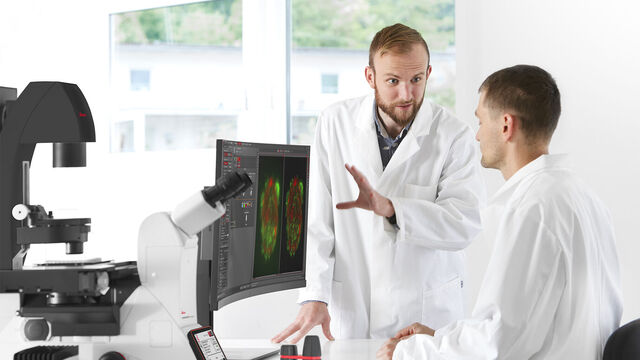
Automated Microscopes
Automated Microscopes
Why automated microscopes?
Automated microscopes are useful for life science fluorescence applications like live-cell and time-lapse imaging (widefield and confocal microscopy) as well as high-speed multi-fluorescence optical sectioning (confocal microscopy). They are also practical for industrial applications like cleanliness analysis, alloy quality rating, and optical inspection of electronic circuit boards (compound, digital, and stereo microscopes). The microscopes have features, such as automated contrast and illumination including fluorescence excitation and emission, motorized focus and parfocality, automatic brightness and diaphragm adjustment, among others. These automated functions make the microscopes more convenient to use and lead to more reliable and reproducible results.
The advantages of using automated microscopes
Automated microscopes offer advantages over manually operated microscopes for certain applications, as repetitious, labor-intensive, time-consuming operations are automated and do not require user intervention. Automated microscopes also enable high-speed operations to be performed more easily and more reliably. They save a considerable amount of time compared to manual operation and enable a faster and more reliable workflow.
An automated microscope requires automated functions
An automated microscope actually has certain functions which are automated. The automation is done by using electronic components, like a digital camera, and intelligent software. For example, focusing, illumination settings, sample movement, changing objectives, can all be automated. The image acquisition time is synchronized with exposure of the sample to light to minimize photodamage if the sample is light-sensitive.
Applications for automated microscopes
Automated microscopes are useful for various applications that require time-consuming and repetitive tasks or high-speed operations. Examples are time-lapse imaging with fluorescence microscopy for life-science applications and inspection and quality control for industrial applications.
Meet Mica
The world’s first Microhub
Mica enables microscopy access for all, removes the constraints of traditional four-color fluorescence imaging and radically simplifies workflows.
Frequently Asked Questions Automated Microscopes
When choosing an automated microscope, one should determine which tasks or operations in the workflow need to be automated in order to save time and increase accuracy and reproducibility. Once the tasks are known, then a microscope with the appropriate automated features, e.g., autofocusing, motorized stage for sample movement, control of illumination settings, changing objectives, etc., can be chosen.
A manual microscope uses optical, electronic, and mechanical components (stage, focusing, illumination, etc.) that need to be operated manually by the user. In an automated microscope, these tasks are automated and do not require the operator’s presence during imaging. An automated microscope can provide more accurate and reliable results and lead to a more efficient and less labor-intensive workflow for users.
Automated microscopes use a combination of electronic components and software which enable automation of repetitious tasks being done in the imaging workflow. Common electronic components for microscope automation are digital cameras, motorized stages for sample movement and focusing, motorized objective nosepieces, automated control of illumination settings, etc.
Automated microscopes are useful for imaging tasks which are repetitious and time-consuming when done manually. Performing such tasks with an automated microscope saves users time and enhances reproducibility of the results. Automation is often needed for life-science applications requiring time-lapse imaging over multiple samples, but also for cleanliness inspection and quality control for electronic components.








